
At a Glance
Pirates who can’t die do battle on the high seas in Rum & Bones, a 2-6 player area control/action point/tower defense miniatures game from Cool Mini or Not. Players try to attack the opposing ship while racking up victory points in this game for players aged 14 and up that plays in about an hour.
Components
I could just say that it’s a Cool Mini or Not game and end this part of the discussion here. CMON is one of those publishers that does great, high-quality components that really enhance your gaming experience. In this big box, you get a pirate’s treasure chest worth of plastic and cardboard. There are:
- 2 big playing boards, one for each ship
- 15 Condition tokens
- 36 Damage tokens
- 6 Dead Man’s tokens
- 6 Deployment tokens
- 3 Gangplank tiles
- 50 Coin tokens
- 1 Sea Dragon tile
- 1 Kraken tile
- 2 Sea Creature cards
- 10 Objective tiles
- 60 Tide cards
- 10 Hero cards
- 8 Six-sided dice
- 10 Heroes (5 for each side)
- 12 Bosuns (6 for each side)
- 48 Deckhand (24 for each side)
- 20 Bases (10 color-coded to each side)
- 1 Rulebook
The cardboard is thick, the miniatures are wonderful with great details, and all of it is really fantastic. One of the best parts about this experience, after you’ve unboxed the miniatures from their careful packed boxes and punched the cardboard from their hefty sheets, is the rulebook. Before you get to the first word of overview, rules, or setup, there’s a great short story that describes the premise for the game. It’s rich in detail and setting and done really well. The back of the rulebook has more information about the creatures and characters in the game and an aftermath to the story. It really is neat and I found myself wondering why more games don’t do this to build the theme.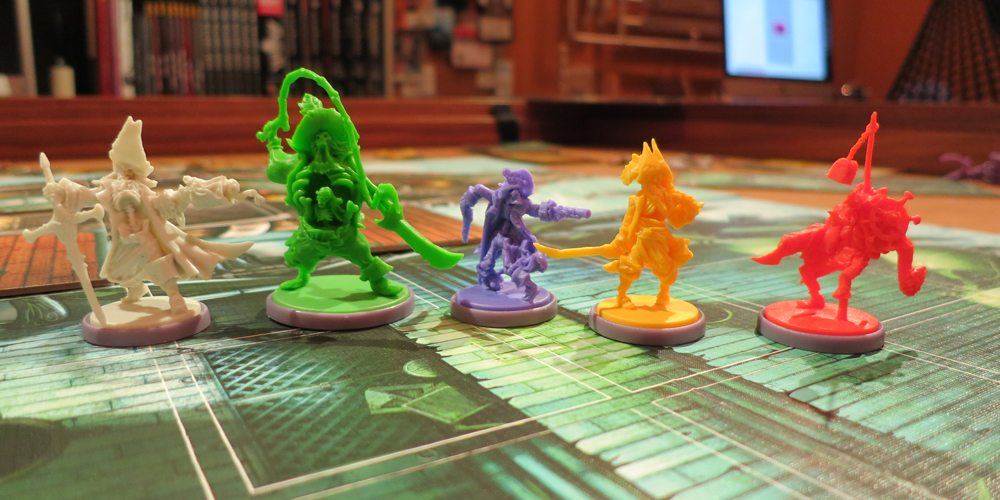
How to Play
Setup is a bit tedious the first time, but after you get through it once, it’s easy to setup in subsequent plays. The board is setup by placing the two ship boards next to each other, broadsides. Gangplank tiles are placed to connect the ships and objective cards are placed on the ships inside outlined marks on the boards.
Players choose a faction and sit on the side with their ships. Each faction gets their own Hero, Bosun, and Deckhand minis, along with some bases. Additionally, each gets Hero cards, six D6, a deck of Tide cards, and all are placed in front of the players. All the other bits–the coins, damage, and other tokens, the creatures, and their cards–are set on the sides of the playing board. Each player places four Deckhands on each of three central objective cards on their ships and play is ready to begin.
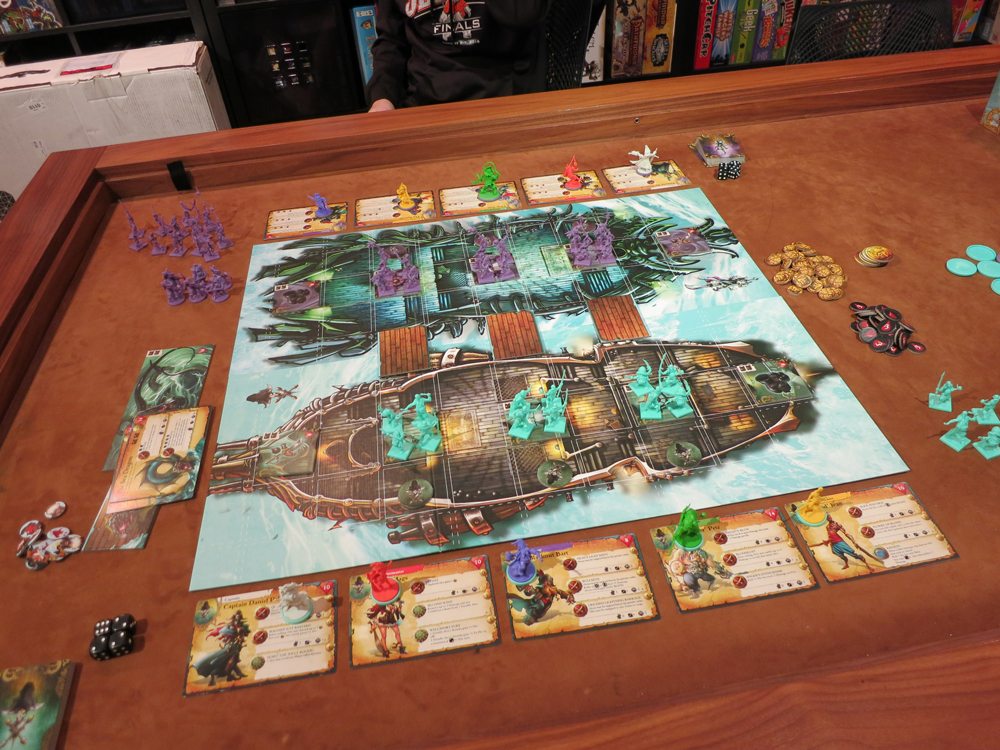
Each round a player completes an entire set of eight steps before allowing her opponent to do the same. Some of the actions vary from round to round, depending on which of your Heroes and grunts have been KO’d, the temporarily incapacitated condition that affects these undead fellows before returning to battle. Though you won’t begin the game with any KO’d characters, it’s easier to address the KO condition as we walk through the game, rather than jump back and forth.
First, a player prepares her Heroes. This means giving a single coin to each Hero who is in reserve, that is, not deployed, not in a state of being KO’d. If a Hero has been KO’d, the Dead Man’s coin that was given to that character upon temporary death is flipped from its dark, ruined side to its shiny gold face that round. If the shiny side of the Dead Man’s coin of a previously KO’d Hero is on its card, the token is removed and the character is now ready to be deployed.
Next, comes a moment of supreme power. A player gets to fire her deck gun. This is done by targeting any zone on the boards and rolling four dice. A result of four or better scores a hit and since all Bosun and Deckhands have a single hit point, well, off the board and into the reserve pool you go to heal and come back to life.
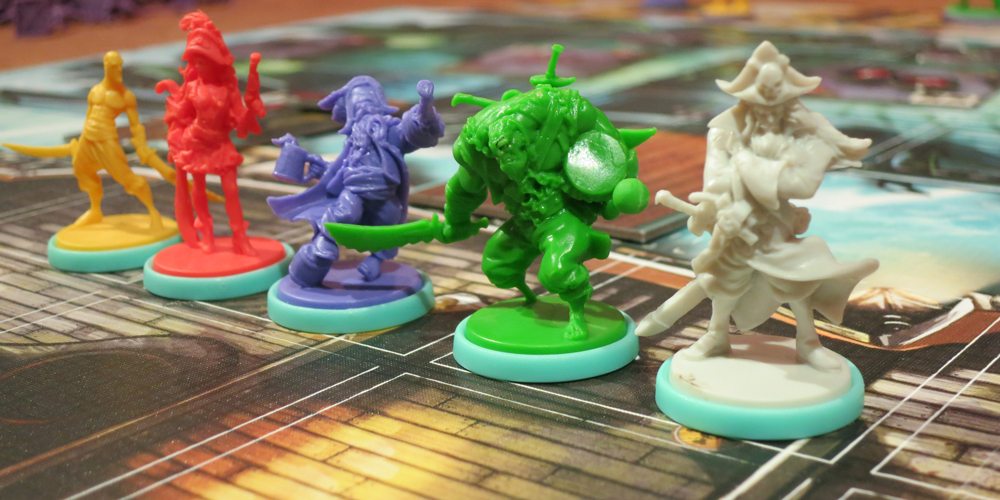
The third and fourth steps involve the drone-like placement and actions of the brain-dead crew. A player places two Deckhands (as long as they are available in the reserve pool) on each of the three Deployment spots and two Bosuns at a deployment of her choice, each located behind an objective tile. If any of your crew is in a zone that is adjacent (all attacks and movement in Rum & Bones are orthogonal) to an enemy, they attack. A single die is rolled for each and a 3 or better hits for Bosuns, 4 or better for Deckhands, each dealing a single point of damage. All of your crew then shamble a single zone in a straight line toward the enemy, ending their role this round. Note, movement into enemy objective tiles, zones occupied by the enemy, and outside the boundaries of the ship are prohibited.
Heroes are up next. A player can have three Heroes in play at a time, those who are deployed count, as well as any who are KO’d and are saddled with a Dead Man’s coin. It’s possible to have three KO’d Heroes and none in play, in which case, your guys ain’t doing much this round. If you have fewer than three Heroes occupied between deployment and Dead Man’s coins, you can deploy Heroes via Deployment points.
Heroes then activate, as the sixth step of the round. Each Hero gets three actions, which are taken all at once before moving on to the next Hero. On a Hero’s turn, a player may choose to perform an attack. Attacks vary among Heroes, with damage, range, and special effect being spelled out on each Hero’s card. Some Heroes may also have special abilities that may be activated; these are also on the Hero cards. Some Heroes also have riposte reactions. Some attacks, ripostes, and abilities are available at no cost, while others have a price associated with them. Those costs are paid to the bank. Heroes gain coins when in reserve, but also get a coin for each enemy crew they take out. If a Hero KO’s an enemy Hero, they get the enemy Hero’s coins. No Hero can have more than 8 coins at any time, as extras are discarded.
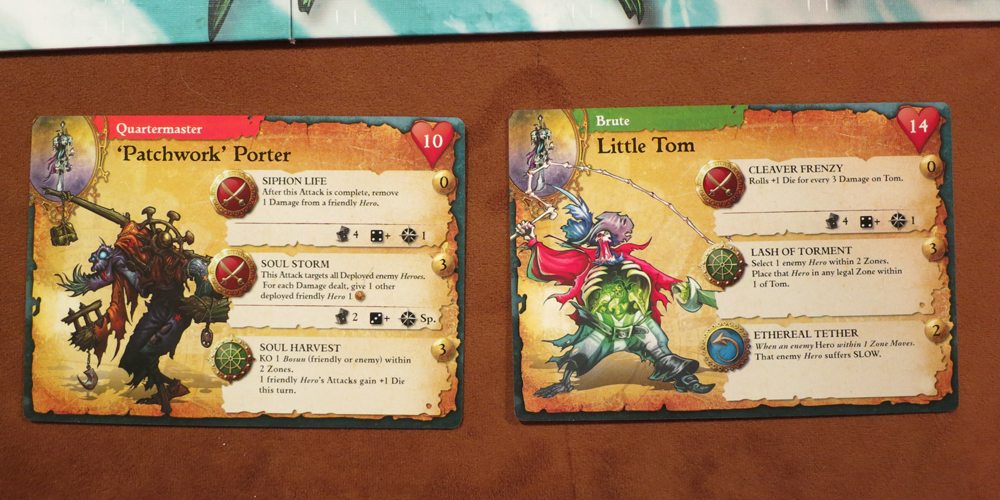
A Hero can use an action to move up to two zones unless an ability increases that range. If a Hero is along the gunwale, that Hero can use “rigging” to swing about or across the ships. Movement is counted as if he were walking across the deck and a single die is rolled in a rigging check. The player must meet or exceed the movement needed to successfully swing into the new spot. If he fails, the Hero is knocked Overboard. The Hero loses all his coins and is placed lying down on his card. On the next round, the Hero is stood up and can be immediately redeployed.
At any point during play, a player can play Tide Cards that meet the triggering condition near the top of the card. These cards provide their owner with a benefit or a detriment to the enemy. Cards are discarded after use and, unless a player has an ability that states otherwise, can only have three cards at once. If a card has a tentacle and Kraken symbol on it, it is discarded in a separate pile after use. Players don’t have any cards to start the game, but at the end of each round, draw up to three or their hand limit. At the end of a player’s turn, she checks the total number of all discarded cards with Kraken symbols on them and then rolls two dice. The result must meet or exceed the Kraken symbol value or the Kraken appears on the game board. This is bad.
Any creature–Kraken or Sea Monster–prevents movement across its position and has an opportunity to attack any player within reach at the end of each turn. When a player has taken all of these steps, the other player gets a turn. There is lots of carnage as crew and Heroes are laid waste. Heroes are a bit tougher to take out because they have higher HP and some regenerate health, but take out enough and you may be able to make your way to an enemy objective point. These areas also have HP and if you reduce them to zero you win that card, which gives the player two victory points and (sometimes) an ability. Creatures also award VP and abilities. First to six victory points wins the game. There are a few other rules–some attacks or Tide Cards give an enemy a condition (like “Stun” which takes away a Hero action or “Silence” which prevents a Hero from using actions that cost coins) and there is an order of attack when targeting a Zone with multiple characters on it, but that’s mainly it.
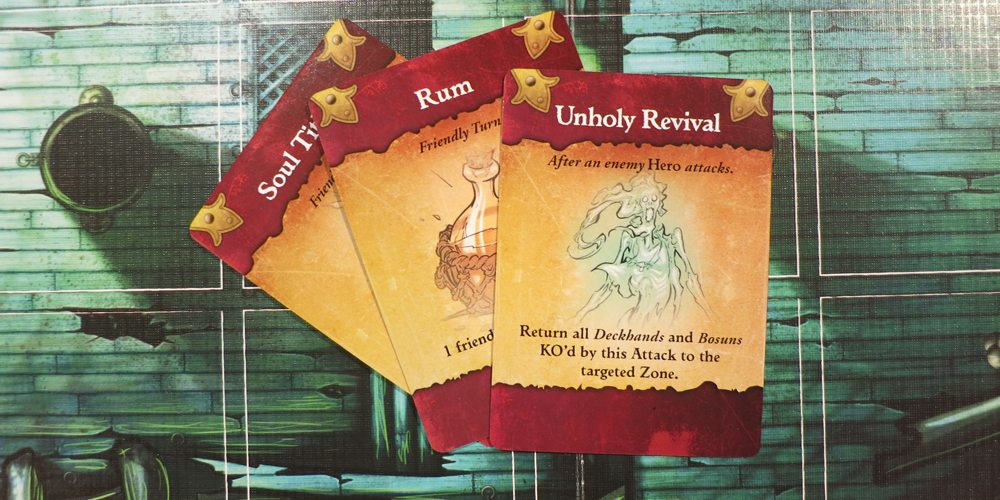
Why You Should Play It
You can play Rum & Bones with up to six players, each controlling a single Hero in two teams, but I absolutely love the game as a one-on-one, head-to-head battle. It moves much more quickly than having multiple players on the same team, and it’s more rewarding this way too. There aren’t many big box games that play really well with two players, so for that, Rum & Bones is great.
There is a bit of downtime as the other side plays, which warrants a tiny complaint, but gameplay moves along quickly enough that it’ll be your turn before you know it. Speaking of speed, you’ll be rotating your crew and Heroes on and off the board over and over again as characters meet their demise, only to be reincarnated a few turns later. It’s a fairly impressive amount of turnover and adds to the game’s fun factor.
The abilities and actions of the Heroes take a bit of time to get used to. After playing the same side three games in a row, I was only just getting used to them and what combination of Heroes worked best together… before I switched and played the other side. Rum & Bones has been out since 2015 and has a huge variety of expansions available for it, so I see this game having a long life for those who really fall for it.

I really enjoyed the quality of the components and having two separate boards makes it really feel like two ships are battling. I remember when I first saw this game at Gen Con last year. At the CMON booth, they had big, 3D models of ships that they were using for demos–that was really neat.
The first player has a pretty good advantage in this game and can nearly decimate the opposition on the first turn, depending on dice rolls. However, with smart, aggressive play it’s not too tough to battle back, and I like giving my kids the opportunity at first strike to even the playing field a bit.
Rum & Bones is a nice combination of luck and strategy and moves quickly, making it a pretty fun game. It’s not too terribly deep, which adds to its speed of play and it’s most enjoyable as a two-player pursuit. We look forward to playing it more in the weeks and months to come.

Disclosure: GeekDad was provided with a sample of this game for review purposes.
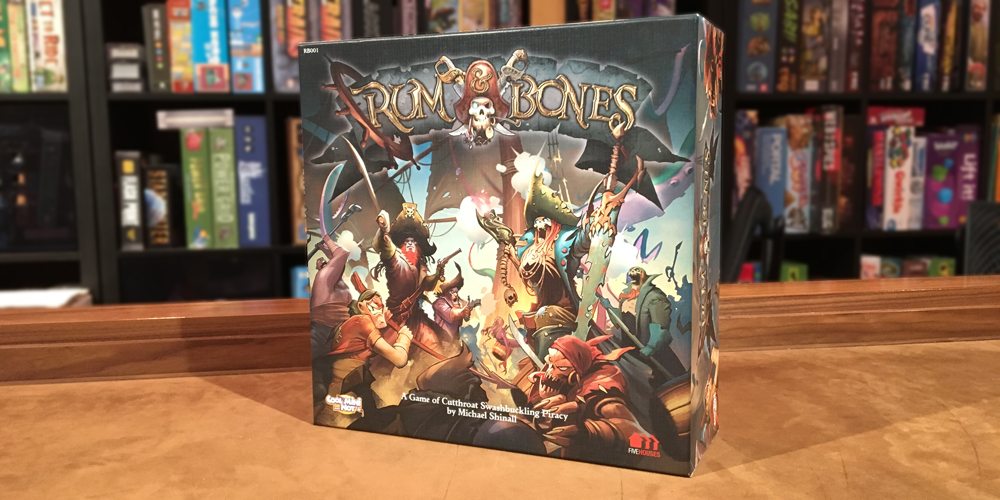

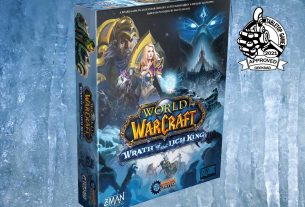


With my gaming friends, we play a house rule where the first player only starts with 1 hero, and the person that goes second starts with two. The next round, both players have a full 3 heroes. Seems to mostly solve that balance issue.
Also, you neglected to mention in your article that there’s Rum and Bones Second Tide, which is a Kickstarter Cool Mini or Not ran earlier this year which is due out in January. It’s both an expansion and a reworking of the rules(there’s also an inexpensive upgrade kit as part of the Kickstarter that updates the original R&B to the new ruleset):
https://www.kickstarter.com/projects/coolminiornot/rum-and-bones-second-tide?ref=user_menu
Good tip on the first round. I’ll try that. Thanks. I did mention that there are a number of expansions for it. I can only accurately review what I’ve seen!
And just a little rules clarification: during crew deployment you place two deckhands on EACH deployment point for a total of 6 crewhands, but then take just two bosuns and place them on any of the three deployment points.
I can see where that’s not clear. Will tweak. Thanks.